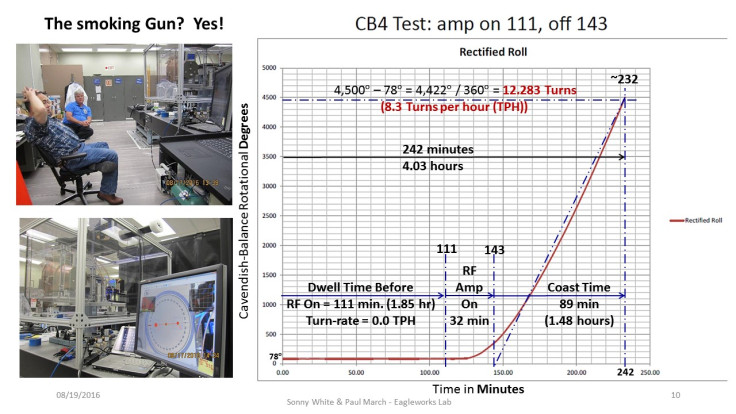EmDrive: Leaked Nasa paper reveals 'Star Trek' microwave thruster does work
An early draft of Nasa Eagleworks' peer-reviewed paper on the EmDrive has been leaked onto the internet.
An early draft of Nasa's much-anticipated peer-reviewed paper on the controversial EmDrive space propulsion technology has been leaked onto the internet by a source close to Nasa Eagleworks, showing that researchers achieved a force of 1.2 millinewtons per kilowatt in a vacuum after errors of measurement were accounted for.
- [UPDATE] Space race revealed: US and China test futuristic EmDrive on Tiangong-2 and mysterious X-37B plane
The paper was leaked onto the Nasa Spaceflight enthusiast forum on Saturday 5 November by an Australian EmDrive fan called Phil Wilson, who goes by the username "The Traveller". Nasa Spaceflight's moderators decided to delete the post, since the paper has not yet been released, as did Reddit's moderators. It is slated to be published by the American Institute of Aeronautics and Astronautics (AIAA) in December.
However, science-tech news site Next Big Future has decided to link to the paper and upload diagrams from it, thus ensuring that the content is now, irrevocably, in the public domain.
IBTimes UK was given access to this early draft of the paper and an accompanying video of an EmDrive experiment in October, but we made the decision not to interfere with the scientific peer review process, as it goes against journalism best practice.
The paper is exciting to EmDrive fans as it indicates Nasa has succeeded in replicating the work British engineer/scientist Roger Shawyer did in 2006 to produce rotating thrusters and prove the controversial device does in fact obey Newton's Laws of Motion.
Nasa Eagleworks researchers detail in the paper that, using light sales and microwave photon propulsion, they were able to produce 3.33-6.67 micronewtons per kilowatt in thrust, which is two orders of magnitude less than Shawyer's 2006 results.

Video showing Nasa Eagleworks' thruster in motion
IBTimes UK published a video of Shawyer's experiment back in 2014, which simulates a 100kg spacecraft on an air bearing being moved counter-clockwise by a microwave thruster. Above is the video of the same experiment, replicated in Nasa Eagleworks' laboratory in 2015.
In the experiment, Nasa's thruster achieved 270 degrees of rotation under power, over 32 minutes, before the battery ran out and then allowed the turntable to rotate 12 turns over a further 89 minutes.
"[It's] all very slow but very convincing. There's some very serious work going on and I expect to see a lot of exciting stuff about the EmDrive in the news in the near future," Shawyer told IBTimes UK.
"It's a nice bit of publicity but really it's nothing new. But for the people who are really sceptical about it, seeing something move is the most important thing. When Galileo was put on trial by the Catholic Church in 1633, he reportedly said of the Earth moving around the Sun, 'Even so, it does move.'"
Concerns that Nasa research won't be published
How the EmDrive works
The EmDrive is the invention of British scientist Roger Shawyer, who proposed in 1999 that based on the theory of special relativity, electricity converted into microwaves and fired within a truncated cone-shaped closed metal cavity causes the microwave particles to exert more force on the flat surface at the large end of the cone (i.e. there is less combined particle momentum at the narrow end due to a reduction in group particle velocity), thereby generating thrust.
His critics say that according to the law of conservation of momentum, his theory cannot work as in order for a thruster to gain momentum in one direction, a propellant must be expelled in the opposite direction, and the EmDrive is a closed system.
However, Shawyer claims that following fundamental physics involving the theory of special relativity, the EmDrive does in fact preserve the law of conservation of momentum and energy.
For a more in-depth explanation about the EmDrive saga, see What is the EmDrive and why should I care?
The Nasa Eagleworks paper does seem to prove that the EmDrive works, however enthusiasts on the Nasa Spaceflight forum feel that the leaked paper is very likely not the same as the one that AIAA will publish, and in fact relates to research dating back to 2014 and 2015, much of which is already known to enthusiasts.
For his part, Wilson says that he chose to release the data onto the Nasa Spaceflight forum because he didn't believe AIAA intends to actually publish the paper.
He is concerned that Nasa could in fact soon decide to close down the Eagleworks Laboratory, which is considered to be a sort of "moonshot" experimental laboratory for investigating fringe theories in advanced propulsion physics.
"All this work was funded by the US taxpayer and conducted by a US government nonmilitary establishment, so nothing done by Eagleworks was classified," he told IBTimes UK.
"Despite that, very significant EmDrive research has not seen the light of day and many around the world make incorrect assumption about the non-functionality of the EmDrive and the work that EW achieved.
"I need to ensure this information sees the light of day and is not held back from the public."
© Copyright IBTimes 2025. All rights reserved.






















